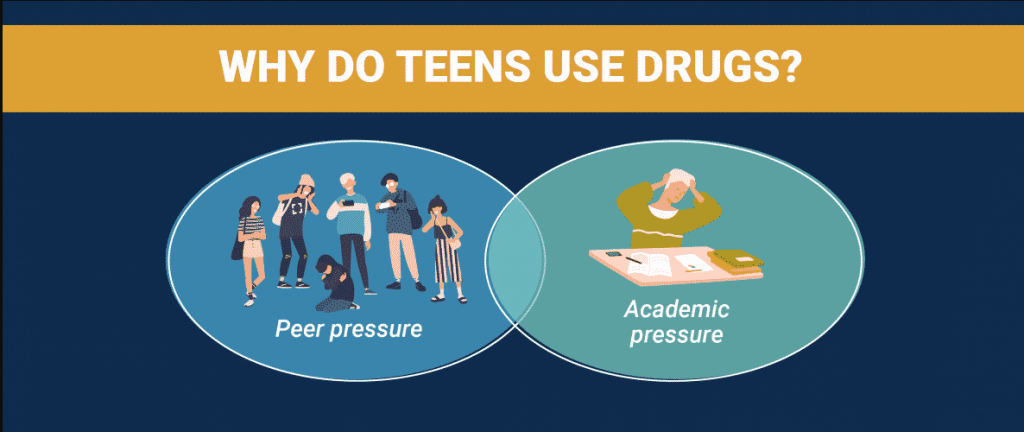Drugs and Behavior: Effects of Alcohol and Substance abuse in Adolescents
Behavioral
Substance abuse is the destructive pattern of using substances such as illicit drugs, prescription drugs, and alcohol, leading to distress or impairment. There exist many negative impacts of substance abuse on adolescents. Substance abuse may result in behavioral problems and related actions that negatively affect their lives. Adolescents addicted and dependent on substance abuse are vulnerable to behavioral problems such as impulsive control issues and reckless and aggressive behaviors crimes such as murder and violent acts. They become hostile and emotional when dealing with others, and most of the time, they neglect and are careless towards the situation (Das et al., 2016).
Psychological
Substance abuse also impacts the mental health of these adolescents. For instance, drug abuse leads to personality disorders, anxiety, depression, and even suicidal thoughts. They are more likely to be pessimistic and think negatively. They experience a feeling of resentment and desperation. They lose self-esteem and cannot tolerate further stress. In the long term run, depression and anxiety can make them kill themselves. Even though some of the psychological effects can be reversed, there are high chances of permanent damage and a condition individuals will live with for the rest of their lives (Brown et al., 2015).
Physical
The physical health of adolescents is also affected by substance abuse. When abusing substances, individuals may be physically hurt via risky actions. Besides, there are high chances of engaging in sexual activities, exposing them to sexually transmitted diseases like HIV/AIDs. Some health problems include impaired hearing, distorted vision, brain seizure, unstable body temperature, and mangled speech (Das et al., 2016). In the long run, high blood pressure and heart rate may lead to heart failure, leading to an unconscious body stage.
Social
Socially, adolescents who abuse drugs are prone to having poor interpersonal relationships. They cannot maintain good connections and communication with their friends, families, and peer relationships. The poor relationship may cause them to have broken families and lose friendships. For instance, some withdraw from friends and family and moves towards those people who have similar drug abuse lifestyles. Some may join violent gangs, leading to more serious criminal activities (Ewing et al., 2015).
Explain the importance of treatment, and detail the different types of treatment options available for substance addictions
There are various treatment options available for those suffering from substance abuse. For instance, long-term treatment programs and facilities exist that can offer patients care for 6 to 12 months. The health care facilities focus on integrating the victims into society. Besides, they are provided appropriate tools to help them adhere to the 12 steps traditional program. The 12 step facilitation is a treatment option based on faith. For instance, it applies a spiritual approach, seeking intervention from God to give them hope (Mountainside, 2017). Treatment is intended to help those who abuse drugs cease and overcome the condition of being captivated drug-seekers. It is not that easy to recover from addiction, and that’s why there are different types of treatment options for drug dependence.
The inpatient treatment option requires that all the addicts stay and reside in a substance-free facility. Here, they receive 24 hours emotional and medical care throughout the whole treatment program. It best suits behavioral and mental problems. There is also an outpatient treatment option in which the patients live and stay at home as they continue with daily routines like family caring. They are provided with counseling and are allowed to attend school at the same time. This treatment option suits patients with mild drug addiction. Besides, detoxification as a treatment option allows them free from addiction until their body is pure from the substance (Das et al., 2016). Therapy plays an essential role in this treatment option.
Explain the benefits of inpatient treatment and a 12-step program
All drug abusers with severe or mild disorders have a high probability of recovering from addiction. This is because it provides full-time concentration for the recovery of each patient. For instance, it offers emotional and medical support on a 24-hour basis, and all the appropriate requirements and needs are addressed (Hudson, 2021). Moreover, patients under this program are free from the outside world and stress since they live in a treatment facility free from distractions of daily life. The benefits of inpatient rehab include a higher success rate of addiction recovery and safety. There is also access to additional well-being features, such as exercise, yoga nutrition, and more therapy options. There are structured programs with necessary medical, peer, and professional support with no drug or alcohol abuse temptation.
In the 12-step program, the patients have the advantage of establishing and making connections with others. The treatment program offers a built-in community structure in which faith and spiritual foundation are at the center. First, it gives the patients a sense of belonging (Donovan et al., 2018). For instance, it allows the patients to meet others with similar conditions. Also, it provides encouragement and support. Participating in a 12 step program and fellowship gives them access to groups who wish nothing more than to see them succeed. Lastly, it provides the dependents with accessibility, honesty, and growth, which helps them admit their mistakes and rebuild relationships affected by their addiction.







